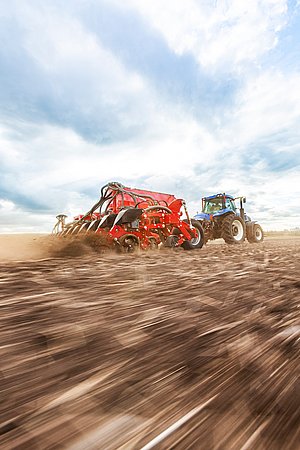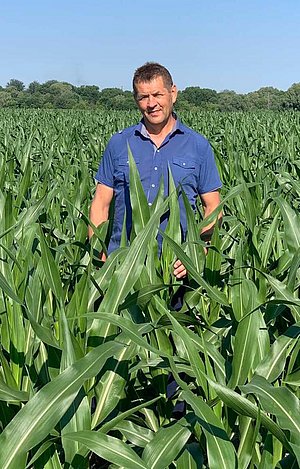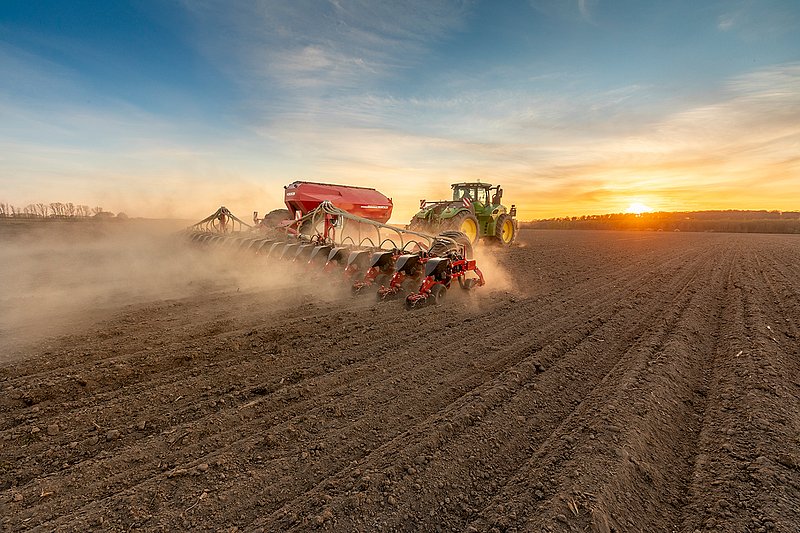Tested and approved
The new HORSCH Maestros are available with two different metering systems. While the AirVac system has already passed its baptism of fire, 2021 is the first serial year for the AirSpeed metering unit. terraHORSCH summarises the impressions.

Fast, precise, versatile – this is how HORSCH describes the main advantages of the new Maestro single grain seed drills. They can be equipped with two different metering units. The design of the AirVac and AirSpeed system is quite similar, and they work according to the same metering principle. The AirVac system singulates by means of a vacuum, the seed is sucked to a perforated disc. The AirSpeed system, however, works according to the overpressure system and the grains are pressed to the perforated disc. The big difference is the transfer of the seed from the metering unit into the soil: with the AirVac system the grains are led into the bottom of the furrow by means of a fall tube and, if necessary, pressed by the catching roller. With the AirSpeed system the singulated grains are captured by an air current, accelerated, and shot into the ground via the shoot pipe. The catching roller is an inherent part of the machine and embeds the seed.
Machines with the AirVac metering unit as a standard equipment were already working last season. The first Maestros SX with the AirSpeed shoot system metering unit were delivered to the customers this spring.
One Maestro 16 SX was delivered to the north-east of the Ukraine, to the Chernihiv. The Itshnanske farm practices arable farming on 12,500 ha. The main crops are winter wheat, spring barley, sunflower, maize and soybeans. They mainly work with John Deere tractors and Claas combines. The farm uses two Tiger 4 MT with mounted fertiliser hopper, two Maestro 24 SW and the new Maestro 16 SX from HORSCH. Moreover, they have a 16-502 direct seed drill, a disc harrow and two ploughs.
The main reason for purchasing the Maestro SX was the enormous efficiency combined with a safe embedding of the grains.
Farm manager Mykola Kopyl details that folding in and out can be carried out very fast. So fast and easily that it does not disturb the processes and that he even did not bother to count the time for the process. And he also praises the handling: “The service technician only explained and showed once how everything works and then we managed perfectly well on our own.” In the shoot pipe the grains pass a sensor that counts the grains, identifies the distance between the grains and thus provides information about double spots and gaps. These values are displayed clearly at the terminal of the machine. As the metering units are driven electrically, each row can be controlled individually. This allows for an individual row switch-off, SectionControl, VariableRate and tramline control. In addition to VariableRate via the whole working width it is also possible, with a corresponding high-resolution application map, to control the seed quantity within the working width related to the individual rows. With regard to the tramline control a percentage addition to the sowing density in the rows at the left and at the right side of the tramline can be adjusted individually.

Mykola Kopyl is also satisfied with the handling of the “hardware”: “Placement depth, closing wheels, trash wheels – everything is adjusted in no time at all. The control elements are easily accessible.”
“The metering discs can be changed very fast”, the farm manager says. “We know how long it took with our previous system. The precision and the placement accuracy for different crops is excellent, too. Our agronomist told me that it was the best grain distribution he has seen so far - even with bad, unequal sized seed. With the Maestro SW metering unit, we sometimes had some problems with small and thin sunflower seed. The AirSpeed metering unit, however, dealt with it extremely well. We kept the automatic coulter pressure regulation turned on continuously and the placement depth was always excellent.
We have one little point of criticism with regard to the hopper size and the coverage: for maize the fertiliser and seed quantity was enough for 30 ha, for microgranular compound we could cover only 20 ha. The tank, thus, could be a little bit larger for our application rate which admittedly in our case is very high.”
But let’s talk about an essential factor on a large farm: efficiency. In the Ukraine we had the experience that the 16-row Maestro SX effected the same performance as a Maestro 24 SW: 200 – 220 ha in 24 hours. The operational speed ranged from 16 to 17 km/h for maize and from 14 to 15 km/ha for sunflowers.

Thomas Murr from the Sales Support Planting at HORSCH is very happy about these values: “They absolutely conform to our data. We officially confirm a maximum operational speed of 15 km/h. But we know about farmers who drove up to 18 km/h. But you always have to keep in mind: the higher the speed, the better the influencing factors have to match. And at 15 km/h everything has to be optimum. This is especially true for the seedbed – the best would be a finely crumbled as well as sufficiently consolidated and very level seedbed. Thus, possible vibrations at the seed row can be avoided. The machine has to run smoothly to make sure that singulation and grain placement still work precisely even at these high speeds. At the Kernel farm in the Ukraine a Maestro 24 SX achieved a top speed of 17 to 18 km/h in black soil. Working in shifts they, thus, were able to sow 400 to 450 ha in 24 hours. It is almost unbelievable, even for us!”
Such a performance, however, requires a corresponding tractive power. “400 hp are not too much for 24 rows“, Thomas Murr confirms according to his experience. “500 hp with a large hydraulic pump sometimes are better. On large farms this often is no problem as the large tillage tractors are not used in spring anyway. The reason is the relatively high oil requirement for the pneumatic system, for at this high speed we need more air than for the vacuum system. In fact, not for the seed, but particularly for the fertiliser as quite a lot of material has to be transported. We equipped the pneumatic system with the largest and the most solid components that are available at the market. Normally the oil is completely provided from the tractor. We offer an on-board hydraulic system via a pto shaft. But in general, the capacities of the tractors are sufficient.
With an increasing speed the requirements for durability and wear resistance of the machine increase, too. The quality of our basic components like parallelograms, basic frame and row bodies is excellent. Large pivot points with bushings, stable bearing and folding and pivot points provide enough reserves for the increasing load. Good care and maintenance of the Maestro SV/SX guarantee operational reliability and high total outputs. For the wear parts fertiliser and seed disc, however, the old principle applies, double speed - quadruple wear. Especially large farms still put up with this anyway. They want to make optimum use of the short windows for sowing.
Although it is the first serial year for the Maestro SX, we already could gather quite a lot of experience with the machine”, Thomas Murr says. “We tested and demonstrated. Some customers even trusted us without a demonstration and bought a machine with the AirSpeed metering - even though the metering system has not been very common so far. A lot of machines were delivered to Eastern Europe, but the machine can be used all over the world including Central Europe. It is interesting that we apparently met the requirements of the different markets well – the sales figures for all working widths and machine categories are very solid.”